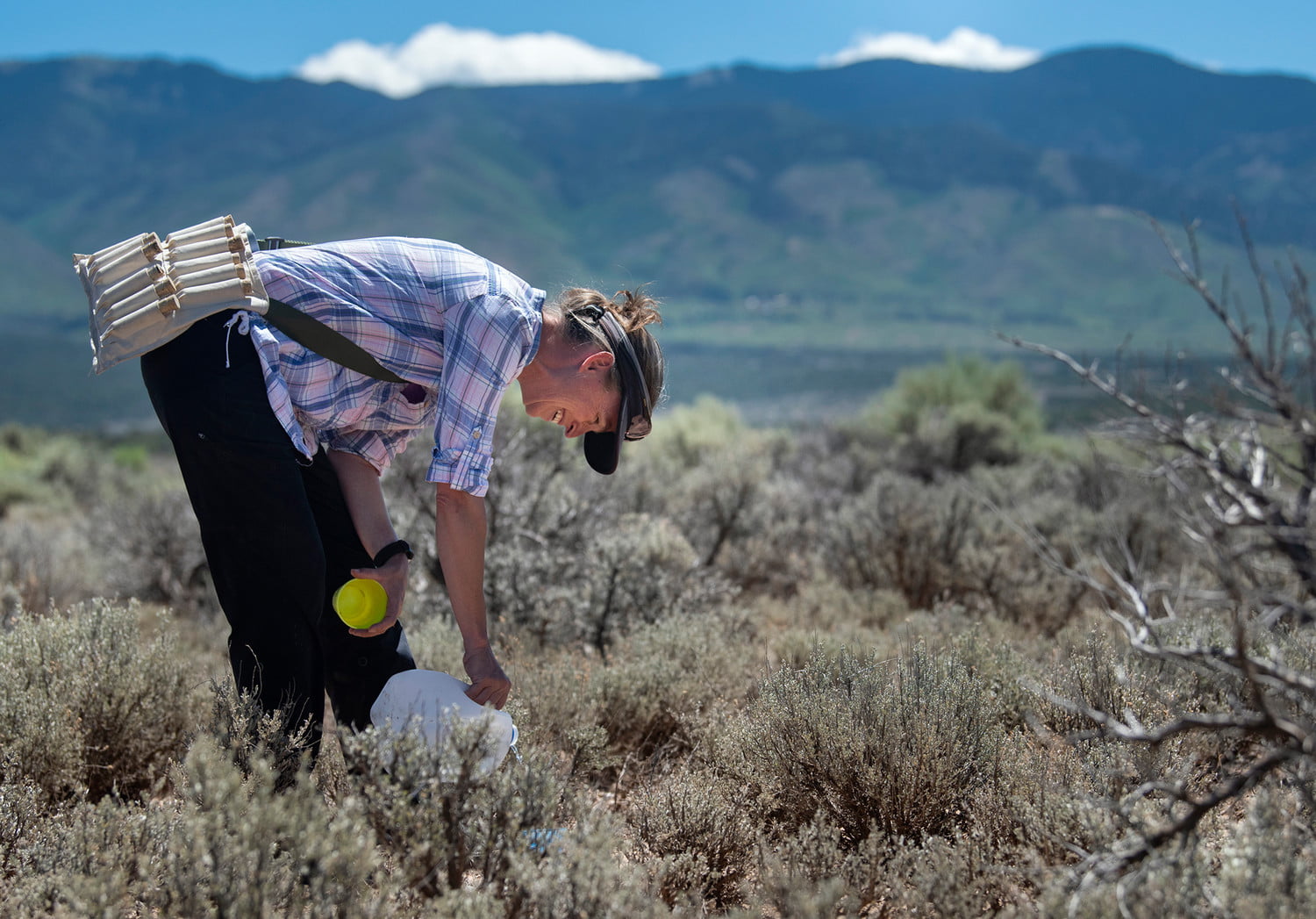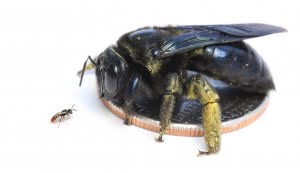
What native bees live in northern New Mexico? New bee inventory sheds light
By Olivia Carril, PhD, IAE partner and contractor
February 2019
The southwest is often characterized by its stark beauty and vast landscapes. Here, rocks that sparkle in a ceaseless sun create a mosaic, from which sprout homely junipers and unwelcoming cacti. Mountains lie silently, 300 miles distant, the view of them uninterrupted by lush trees, rolling hills, or even humid air. In the absence of vegetation, noisy invertebrates, or the smell of running water, many have labeled this area a wasteland. To native bees, however, the southwest is a mecca; the deserts are to bees what the tropics are to butterflies or beetles.
Native bees abound in the southwest. Of the 4000 species estimated to live in the U.S. and Canada, one quarter are thought to be found in New Mexico alone. These bees look little like the honey bee. Many are a few millimeters in size, appearing more like pollen dust swirling above late-blooming perennial shrubs. Others sound like WWII bombers—hovering, legs tucked tight, appearing to concentrate as they attempt the difficult task of landing their shiny black gumball-sized bodies on the pink corolla of a nodding Palmer’s Penstemon. None of these native bees live in hives. Instead the majority are referred to as ‘solitary.’ Each female builds her own nest, usually a hole she has dug in the ground, in which she places eggs, one per carefully constructed chamber along a main tunnel. Each chamber also gets a giant ball of pollen that she has harvested from flowering plants that are in bloom at the time, combined with a species-specific amount of nectar that she carries back in her crop. The nest is sealed, and she is dying just as her eggs hatch, and the larvae begin the year long process of developing into next years’ pollinators.
Each bee species has an inimitable, and fascinating life history. Despite their abundance, and the unique evolutionary pathway each has maneuvered in order to exist today, we know little of their most basic biologies; where, specifically, they occur, their habitat and nesting preferences, floral resource requirements, and population dynamics from year to year. As evidence mounts that at least some of the better studied bees* are experiencing declines in Europe and North America, scientists are working to gather baseline data on less well-studied bees, so that they might respond appropriately in coming years.


The Institute for Applied Ecology ‘s Southwest Office is working with this blog's author Olivia Carril, PhD Melittologist (bee scientist), on a project funded by the Bureau of Land Management (Taos Field Office) to document bee populations in north-central New Mexico. I have been studying bees for over 20 years, and have participated in inventories of bees in Pinnacles National Monument (California), Zion National Park (Utah), Clark County (Nevada), Yosemite National Park (California), and Grand Staircase-Escalante National Monument (Utah). Together with IAE, I am now inventorying the bees of Rio Grande del Norte National Monument (RGNM). At over 240,000 acres, RGNM is an excellent landscape in which to study the bees associated with several of the larger ecoregions of New Mexico. Here, elements of cold desert/sagebrush steppe mingle with plants from the Rocky Mountains and front range. And through the middle runs the Rio Grande River, a corridor for floral elements more typically associated with hot deserts further south. Poking up from the relatively flat sagebrush ecoregion that makes up the majority of RGNM are small volcanic islands, many with an elevation 500-1000 feet higher than the surrounding area. The tops of these areas are characterized by aspen, ponderosa pine, and typically montane understories.
Our project aims to not only inventory all bee species for the monument, but also to document plant-bee interactions, identifying which of the flowering plants that are found in the monument are most attractive or important for bees. In addition, we have established a series of one-hectare plots in a burned and unburned juniper woodland, a grazed and ungrazed sagebrush habitat, and in a riparian area. Plots are sampled once a month in a standardized way so they can be compared to each other to assess the importance of different habitats to bee diversity. Furthermore, we can look at bee populations across years by comparing species abundance in the same plot in successive years. As 2018 was an exceptionally dry year, we also will have the opportunity to evaluate bee responses to droughts.
One year of sampling remains for the project. Bee identifications are ongoing, with many groups morpho-sorted at this point, but not yet compared to reference materials residing in insect collections. Thus, our findings to date are tentative. Before the start of this project in 2016, fewer than 40 bee species were known from Taos County. Tentatively, we have identified 32 genera of bees in RGNM, and at least 140 species. One very exciting find was the rare Ericrocis lata, a cleptoparasitic bee, and its host Centris (likely caesalpinae). Two nesting sites for Diadasia australis have also been identified, and at least one appears to have been used for multiple years.
Without species identifications being complete, comparisons of plots are not robust. Preliminary data, based just on abundance, however, shows that burned areas harbor significantly more individuals than other plots. Riparian areas, which boast some blooms even in dry years, are also areas that support a greater abundance of bees. With time and further analysis, richness and diversity measures can be added to our understanding of plots.
In our final year, the focus will be on collections in areas we have not yet sampled in the monument, as well as resampling montane island habitats. Additionally, another year of collections in plots will allow us to compare a drought year to a relatively wet year, and the effect of each on bee populations. Our hope is that our work in RGNM will provide the monument not only with the knowledge of which bees reside here, but also what resources they require. Our long-term plots can be resampled by monument personnel for years to come, and can provide insight into bee population shifts over time; as the climate changes, as plant populations pulse, and in response to various land management practices. Moreover, as the monument is relatively protected land, the presence of pesticides, the impact of significant habitat modification, and the fragmentation of connected environments is limited, providing a backdrop against which to measure bee populations in areas more susceptible to pollinator threats.
*Bumble bees and honey bees are better known because they live in colonies (in the case of bumble bees) or hives (in the case of honey bees). It is easier to monitor year to year trends for bees that live together in groups of 100-10,000 individuals, than it is for the solitary bee, whose nest may look remarkably similar to a nail hole in the ground.
Restoration
Research
Education
Get Involved
Contact
Main Office:
4950 SW Hout Street
Corvallis, OR 97333-9598
541-753-3099
[email protected]
Southwest Office:
1202 Parkway Dr. Suite B
Santa Fe, NM 87507
(505) 490-4910
[email protected]
© 2024 Institute for Applied Ecology | Privacy Policy